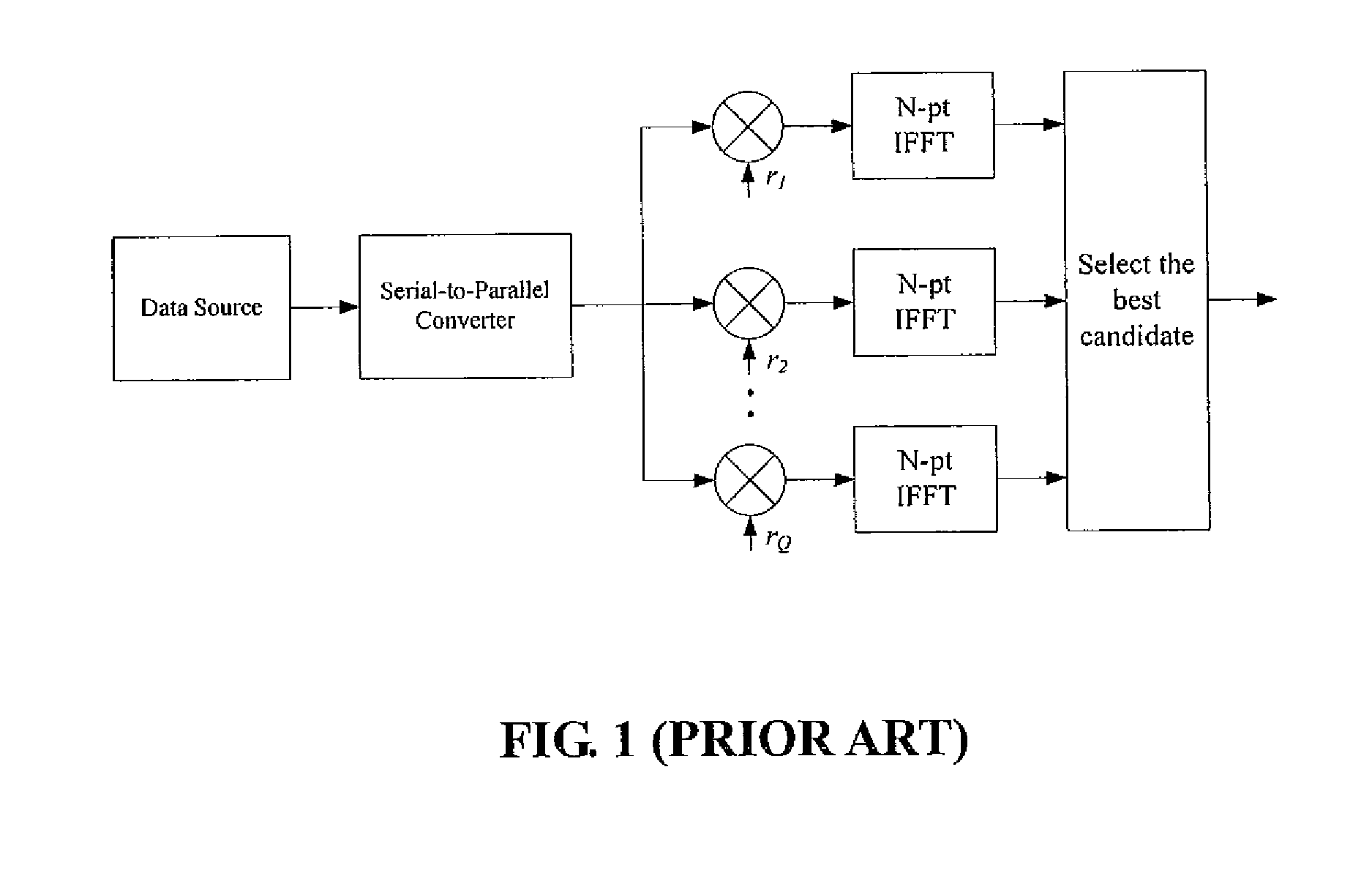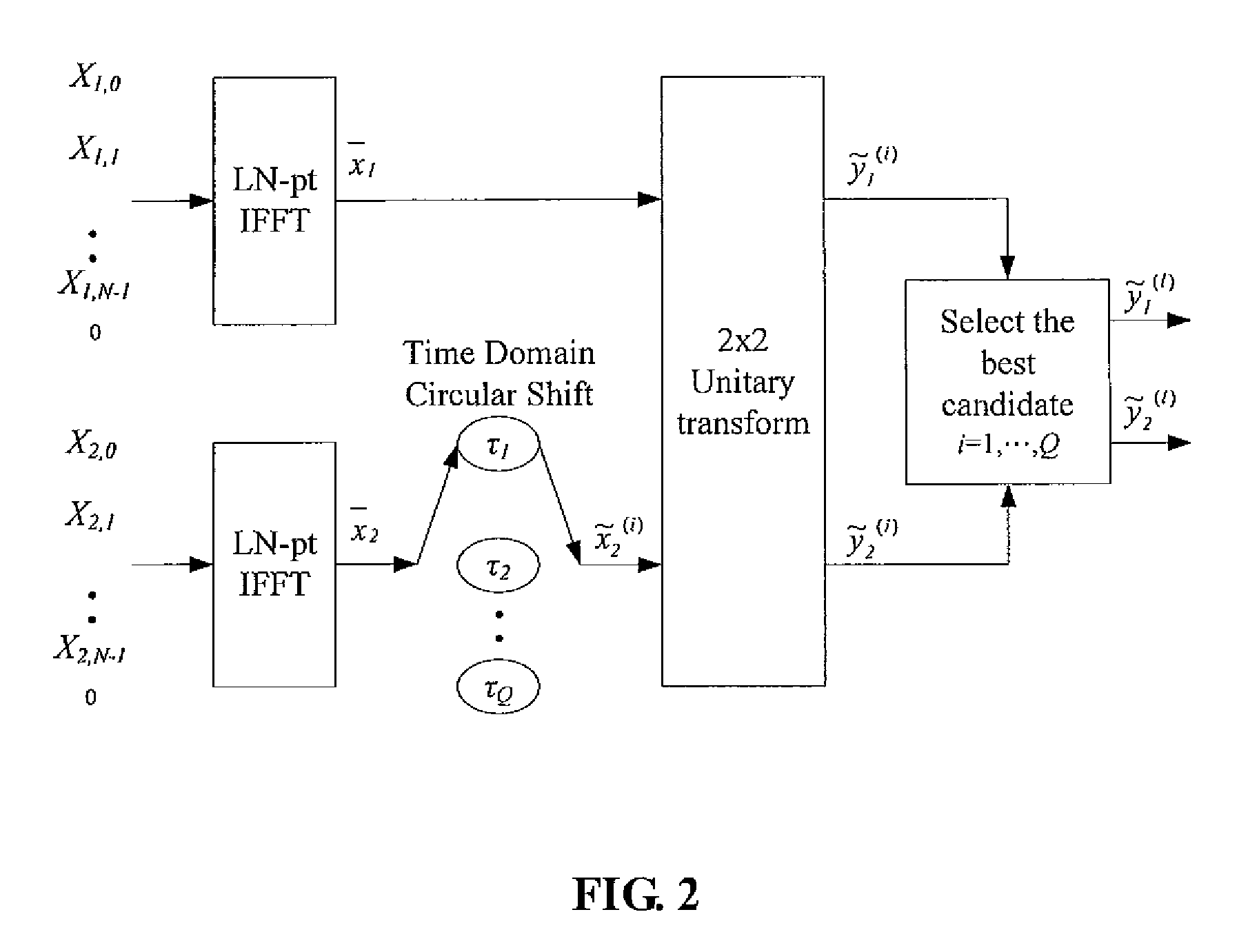Method for solving high papr problem of mcm communication system using unitary transform
a technology of multicarrier modulation and power ratio, applied in the field of multicarrier modulation system, can solve the problems of high peak-to-average power ratio of mcm system, time-domain signals of mcm system usually suffer the problem of high peak-to-average power ratio, etc., and achieve the effect of solving the problem of difficult design of such a power amplifier
- Summary
- Abstract
- Description
- Claims
- Application Information
AI Technical Summary
Benefits of technology
Problems solved by technology
Method used
Image
Examples
first embodiment
[0018]FIG. 2 is a schematic diagram showing the present invention, which performs 2×2 unitary transforms for a MCM system having N (N≧2) sub-carriers.
[0019]First in step 1, in order to achieve more accurate estimation of the PAPR, the present embodiment supplements (L-1)N zeros (L≧1) to the baseband signal blocks X1=(X1,0, X1,1, . . . , X1,N-1) and X2=(X2,0, X2,1, . . . , X2,N-1), respectively, so that X1 and X2 become (X1,0, X1,1, . . . , X1,N-1, 0, . . . ,0) and (X2,0, X2,1, . . . , X2,N-1, 0, . . . ,0).
[0020]The baseband signal blocks X1 and X2 then undergo LN-point IFFT (denoted as “LN-pt IFFT” in the drawing), respectively, to obtain L-time oversampled time-domain signal blocks x1=(x1,0, x1,1, . . . , x1,LN-1) and x2=(x2,0, x2,1, . . . , x2,LN-1).
[0021]Subsequently, in step 2, x2 undergoes Q (Q≧1) different Time Domain Circular Shift with parameters τ1, τ2, . . . , τQ (all greater than zero) respectively to obtain {tilde over (x)}2(i)=TS( x2,τi)=(a2,1(i),a2,2(i), . . . ,a2,n(i...
second embodiment
[0027]FIG. 3 is a schematic diagram showing the present invention, which performs circular shift in the frequency domain in contrast to the circular shift in the time domain performed by the previous embodiment.
[0028]Step 1 is identical to the previous embodiment and (L-1) zeros (L≧1) are supplemented to the baseband signal blocks X1=(X1,0, X1,1, . . . , X1,N-1) and X2=(X2,0, X2,1, . . . ,X2,N-1), respectively, so that X1 and X2 become (X1,0, X1,1, . . . , X1,N-1,0, . . . ,0) and (X2,0, X2,1, . . . , X2,N-1,0, . . . ,0). The baseband signal blocks X1 and X2 then undergo LN-point IFFT (denoted as “LN-pt IFFT” in the drawing), respectively, to obtain L-time oversampled time-domain signal blocks x1=(x1,0, x1,1, . . . , x1,N-1) and x2=(x2,0, x2,1, . . . , x2,LN-1).
[0029]Then, in step 2, x2 is processed by the following function for Q times sequentially:
b2,n(i)=x2,ne−j2roiki1LN,n=0,1,Λ,(LN-1),i=1, . . . ,Q
The function is equivalent to subjecting frequency-domain signal block (X2,0, X2,1...
PUM
 Login to View More
Login to View More Abstract
Description
Claims
Application Information
 Login to View More
Login to View More - R&D
- Intellectual Property
- Life Sciences
- Materials
- Tech Scout
- Unparalleled Data Quality
- Higher Quality Content
- 60% Fewer Hallucinations
Browse by: Latest US Patents, China's latest patents, Technical Efficacy Thesaurus, Application Domain, Technology Topic, Popular Technical Reports.
© 2025 PatSnap. All rights reserved.Legal|Privacy policy|Modern Slavery Act Transparency Statement|Sitemap|About US| Contact US: help@patsnap.com



